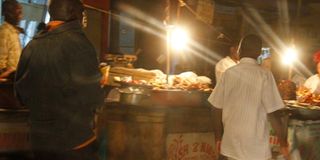Night-time street meals changing life in suburbs

There is no need to choose between having fun and filling your belly in Kampala these days. If you don’t mind sharing a table with strangers then you will enjoy these night markets. Have an open mind when setting out because you never know when law enforcers will pounce. Photos by Abubaker Lubowa
What you need to know:
Despite the mushrooming coffee shops and restaurants, a surge of evening makeshift restaurants in city suburbs have untold delicacies. Sheila Wamboga writes.
Last week, I was walking through Ntinda Trading Centre at night. I could not believe what I was seeing.
The sidewalks had transformed into one disorganised food court. On either side of the streets, red hot charcoal stoves were either being used to roast meat and chicken, cook local food or pan fried French fries.
I was trying to make my way to the market and these distractions were not planned for.
One woman was vending tea and porridge while the jack fruit seller positioned himself strategically near the taxi stage, targeting both passengers and touts.
This setup is not restricted to Ntinda only.
Make-shift food courts
Any neighbourhood of a congested working area in the city is dotted with delicious street platters.
Sarah Namata, a mobile money operator in Bweyogerere cannot thank the innovators of the street food court enough.
She says, due to the nature of her work I hardly has enough time to cook but with the innovation of the street food court, she is spoilt for choice. “I can eat junk food, local food, fruits or even just get tea to take with me.”
The deal
Surely, these are delicacies that most local restaurants offer but as Namata points out, on the street everything is served at half the price most eateries will ask for. The meals at these food stalls costs between Shs5,00 and Shs3,000.
These prices have a cosmopolitan appeal because the taxi tout, student, miser or even an adventurous soul can afford a decent meal with ease.
By the way, the roadside banquet is not just a haven for cash strapped singletons and students who are too lazy to cook, everyone is welcome to partake.
Sula Kaggwa, a technician says he can afford a decent meal at a local restaurant if he wanted. However, he prefers to frequent the road side eatery because it reminds him of his heritage.
“In the village, we would gather and eat supper as a small community and as we had this communion, we would talk about the day’s challenges and successes. I cannot get that at the restaurant. I am simply given a menu and as soon as the meal is done, I have no business in that restaurant.”
He says this is not the case at the roadside restaurant. Kaggwa says the cooks who double as the waitresses will quickly create room for a new client and engage them in small talk as they eat away.
Asked if he is not scared of his meal being emptied by the city authorities who confiscate items from such make shift restaurants, Kaggwa simply laughs.
How did the practice begin?
The first place that comes in mind while talking about street food in the city is perhaps the Old Taxi Park. For decades now, come evening, the park transforms into a gigantic food court.
It is easy to identify these eateries; usually the operators make use of wick lamps while others convert waiting empty taxis into a seating area.
Aisha Nazziwa has been operating in the park for the last 15 years. She says one thing that has not changed in the city is people’s love for tasty street food. “I can proudly say I have a fixed clientele who will look for me no matter where I operate from.”
Asked why she does not expand her eatery into a conventional restaurant, Nazziwa says she makes more money from this initiative. She says, “I save on money for rent and besides that, street dining is all I know.”
In Nakawa, the road that separates UMA showground from the market has a tweak to it. In the evening, it is hard to navigate past the human jam. The food court here specialises in yams, cassava, white ants, liver, plantains and pancakes.
Why the business is thriving
Many attributed the booming makeshift business to the presence of low income earners who lived a stone’s throw from the market.
However, many years after the so called Naguru tenements were evicted, the evening food market has thrived.
One would think that with the outbreak of typhoid in the city, the number of clientele at street restaurants has gone down.
Nazziwa says on the contrary, people dining on the streets have increased because unlike conventional restaurants that have leftovers, in their case everything gets sold out since the kitchen is open for the better part of the night.
Policy
Peter Kaujju, the spokesperson for Kampala Capital City Authority in an earlier interview said, “one of the biggest challenges we still face in fighting this vice is that the general public in the city continues to support the illegal activities of vendors and hawkers by continuing to buy their merchandise fully aware that KCCA condemns this practice.”
Those caught buying items, according to KCCA, will be charged with abetting a crime while the vendors will be charged with carrying out illegal vending.
Verdict
Rich as the aroma is, it is worth noting that some of the food at these stalls is pre-cooked and one has to exercise blind faith and believe that proper hygiene was observed during preparation.
That aside, if the city planners could organize the food hawkers and have them operate in mini-hawking centres, with each hawker allotted a stall, the spirit of street food would thrive except that it would be in a place where there’s water and sanitation. And it’s still very cheap.




